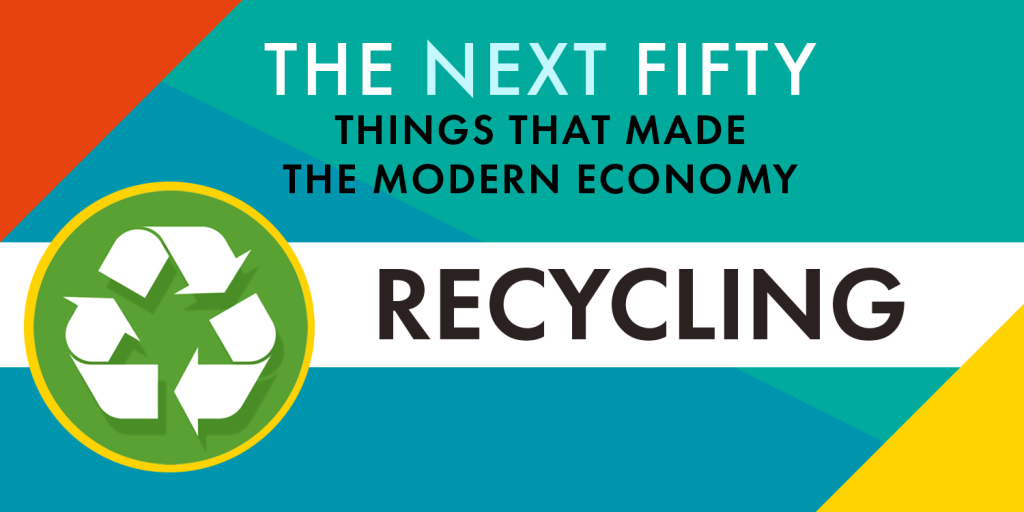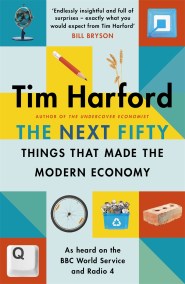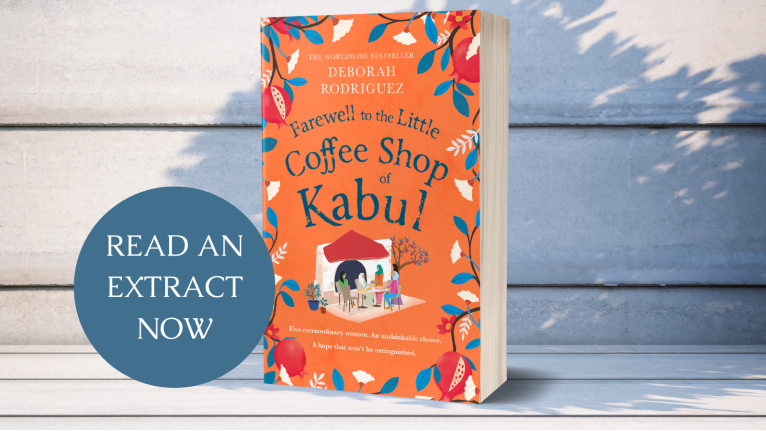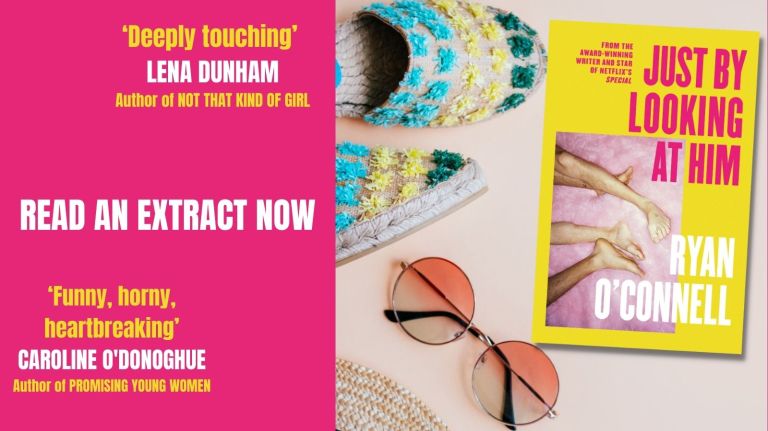The Next Fifty Things That Made the Modern Economy – Recycling

In Fifty Things that Made the Modern Economy, the revolutionary, acclaimed book, radio series and podcast, bestselling economist Tim Harford introduced us to a selection of fifty radical inventions that changed the world.
Now, in this new book, Tim Harford once again brings us an array of remarkable, memorable, curious and often unexpected ‘things’ – inventions that teach us lessons by turns intimate and sweeping about the complex world economy we live in today.
To celebrate publication, we’re sharing extracts of five of the fifty things Tim includes in his new book. Today we’re shining the spotlight on recycling.
Sail up the Pearl River estuary from Hong Kong, past Shenzhen, and you come to the industrial city of Dongguan. Here you’ll find what may be the world’s biggest paper mill, larger than 300 football pitches1. It’s owned by Nine Dragons, a recycling company started by Zhang Yin, who was once ranked by Forbes as the world’s richest self-made woman.2 Nine Dragons is – or, perhaps, was – the largest importer by volume of American goods into China.3 Those goods? Waste paper – typically with some less useful trash mixed in. It’s among many Chinese companies that built business models around importing what Americans and others put in their recycling receptacles, and picking out stuff that shouldn’t be there.4 That’s a crucial job: if the waste is too contaminated, you can’t recycle it. It’s also a job that’s hard to automate. Perhaps one day robots will sift through our trash as deftly as Wall-E in the Pixar movie – but, for now, we need humans. So rich countries started shipping their waste to countries where workers are poor enough to sort it for wages low enough to turn a profit.5
From the 1980s until very recently, this system worked smoothly. China’s fast- growing economy was exporting lots of manufactured goods. And because those ships would otherwise return empty, it was cheap to load them with waste for China to recycle.6 Entrepreneurs such as Mrs Yin made a fortune. But as China got richer, the government decided it no longer wanted to be a dumping ground for the rest of the world’s badly sorted rubbish. It 2017 it announced a new policy, called National Sword, so strict that most experts thought it wouldn’t happen. But on New Year’s Eve that year it did: abruptly, China would now accept only wellsorted rubbish, no more than one half of 1 per cent stuff that shouldn’t be there. That was a big change – contamination rates used to reach 40 times higher.7 The amount of waste being shipped to China plunged.8
Governments and recycling companies scrambled. Should they find other countries still poor enough to accept their badly sorted waste? Or raise taxes to pay higher- wage workers to sort it better? Or something else? Let’s come back to that conundrum via a brief history of recycling. And here I should distinguish recycling from reusing – there’s a reason the ‘reduce, reuse, recycle’ mantra is in that order. Take glass bottles: if you can rinse and refill them, that makes more sense than crushing and melting them to make new ones.
Examples of reuse go back before paper, to papyrus: Ancient Greece gave us the word ‘palimpsest’, which literally means ‘scraped clean to be used again’.9 As for recycling, the Romans melted old bronze statues to sculpt new ones.10 A thousand years ago, Japan was pulping paper to make more paper.11 For centuries people have scraped a living by scavenging for scrap, such as rags to sell to paper mills.12 But that was all driven by saving or making money: the raw materials were too valuable to be thrown away. The idea that we should recycle because it’s the right thing to do is much more recent.
To see how attitudes have changed, look at Time magazine from August 1955. There’s an article headlined ‘Throwaway Living’, and the adjective isn’t pejorative – it’s celebratory. The subtitle is ‘disposable items cut down household chores’. An image shows a smiling family filling their bin with paper plates, plastic cutlery and other objects that, the article tells us, ‘would take 40 hours to clean – except that no housewife need bother’. Why wash up after cooking when you can use a foil ‘Disposa- pan’ – or a throwaway barbecue, complete with a handy asbestos stand?13 A TV ad campaign known as ‘The Crying Indian’ helped shift the mood, in America at least.14 First shown in 1971, it depicted a Native American man paddling his canoe down a trash- polluted river; then he stands by a highway as a passing motorist tosses a bag of fast- food detritus at his feet. ‘Some people have a deep, abiding respect for the natural beauty that was once this country. And some people don’t. People start pollution. People can stop it.’ The Native American man turns to the camera, a single tear rolling down his cheek.15
But the advert wasn’t all it seemed, and not just because the actor later turned out to be a second- generation Italian immigrant.16 It was funded by an organisation backed by leading companies in the beverage and packaging industries. At the time, deposit schemes were common: you’d buy a fizzy drink, and get some cash back when you returned the bottle. This model assumes it’s the manufacturers’ job to provide the incentives and logistics for returning waste.17 The Crying Indian had a different message. Who’s responsible? People. Deposit schemes fell out of fashion. Recycling logistics became seen as a matter for local government.18 The historian Finis Dunaway argues that turning ‘big systemic problems into questions of individual responsibility’ was a bad idea; it made recycling less about effective action, more about making ourselves feel good.19 That seems to chime with research by behavioural economists at Boston University, who found that when people know they’ll be able to recycle, they act more wastefully.20 That wouldn’t matter if recycling was cost- free; of course, it isn’t. The economist Michael Munger develops a similar argument. You can’t just leave waste disposal to the free market – if you charge people what it really costs, you tempt them to dump it illegally instead. You have to subsidise it. But that incentivises the behaviour in Time magazine – people chuck stuff away, and society bears the costs. How do we get them to recycle instead?
One solution is moral suasion, for example The Crying Indian. But that creates a problem, says Munger, in an essay for the libertarian think tank the Cato Institute. For each kind of waste – glass bottles, plastic coffee cups – what we should do is coolly compare the costs and benefits of recycling against other options. Well- designed landfills are nowadays pretty safe, and we can harness the methane they produce for electricity.21 Modern waste incinerators can be a clean- ish source of power.22 If instead we turn recycling into a moral good, when do we stop? Which brings us back to the conundrum posed by China’s National Sword policy. Some say we should pare back recycling programmes, collecting only what everyone agrees it makes sense to recycle, such as corrugated cardboard and aluminium cans.23 That’s one way to make sorting easier. But it seems like a backward step. People in Taiwan seem to sort their own rubbish well enough, so why can’t everyone else?24 Perhaps we need systemic answers: maybe regulators can encourage new business models like those bottle- deposit schemes, making manufacturers think through the incentives and logistics for recycling their products. Those discussions are happening under the voguish phrase ‘the circular economy’.25 Or perhaps technology will come to the rescue.
One UK start-up says it can turn mixed plastics, notoriously difficult to recycle, back into the oil they came from.26 A mall in Australia recently debuted an AI-enabled trash can which senses what you put in it and sorts accordingly; it even looks a bit like Wall-E.27 State-of-the-art sorting facilities use lasers and magnets and air jets to separate different recyclable streams.28 None of this can yet compete with low-cost labourers in China – but maybe closing off that option will prove just the spur to innovation that the industry needs.
All reference sources for this extract are below
1. Dongguan Base, Nine Dragons Paper, http://www.ndpaper.com/en/business/dongguanbase.php.
2. Monica Sanders, ‘Zhang Yin: The World’s Richest Woman’, https://www.legalzoom.com/articles/zhang-yin-the-worlds-richest-woman.
3. Evan Osnos, ‘Wastepaper Queen’, New Yorker, 23 March 2009, https://www.newyorker.com/magazine/2009/03/30/wastepaper-queen.
4. Adam Minter, ‘Nine Dragons and a Whole Lotta Labor’, 12 March 2008, http://shanghaiscrap.com/2008/03/nine-dragons-and-a-whole-lottalabor/.
5. ‘A Chinese ban on rubbish imports is shaking up the global junk trade’, Economist, 17 September 2018, https://www.economist.com/special-report/2018/09/29/a-chinese-ban-on-rubbish-imports-is-shaking-up-the-globaljunk-trade.
6. ‘A Chinese ban’.
7. Bob Tita, ‘Recycling, Once Embraced by Businesses and Environmentalists, Now Under Siege’, Wall Street Journal, 13 May 2018, https://www.wsj.com/articles/recycling-once-embraced-by-businesses-andenvironmentalistsnow-under-siege-1526209200.
8. Leslie Hook and John Reed, ‘Why the world’s recycling system stopped working’, Financial Times, 25 October 2018, https://www.ft.com/content/360e2524-d71a-11e8-a854-33d6f82e62f8.
9. https://en.wikipedia.org/wiki/Palimpsest.
10. Martin Medina, The World’s Scavengers: Salvaging for Sustainable Consumption and Production (Lanham, MD): AltaMira Press, 2007), pp. 20–21.
11. Dard Hunter, Papermaking: The History and Technique of an Ancient Craft, 2nd ed (New York: Knopf, 1957), p. 54, quoted on ‘Some of the Earliest Paper Recycling Occurred in Japan’, Jeremy Norman’s online History of Information, http://www.historyofinformation.com/expanded.php?id=3977.
12. Medina, The World’s Scavengers, 2007), p. 70.
13. Life, 1 August 1955, available at: https://books.google.co.uk/books?id=xlYEAAAAMBAJ&pg=PA43.
14. Olivia B. Waxman, ‘The History of Recycling in America Is More Complicated Than You May Think’, Time, 15. November 2016, http://time.com/4568234/history-origins-recycling/.
15. https://www.youtube.com/watch?v=j7OHG7tHrNM.
16. Ginger Strand, ‘The Crying Indian’, Orion Magazine, 20 November 2008, https://orionmagazine.org/article/the-crying-indian/.
17. Finis Dunaway, ‘The “Crying Indian” ad that fooled the environmental movement’, Chicago Tribune, 21 November 2017, https://www.chicagotribune.com/news/opinion/commentary/ct-perspec-indian-cryingenvironment-ads-pollution-1123-20171113-story.html. Next Fifty Things that Made the Modern Economy CC 3rd.indd 320 06/03/2020 12:29 Notes 321
18. Michele Nestor, ‘Facing the Reality of Recycling Economics’, Waste360, 4 August 2016, https://www.waste360.com/business/facing-reality-recyclingeconomics.
19. Dunaway, ‘ “Crying Indian” ad’.
20. Monic Sun and Remi Trudel, ‘The Effect of Recycling versus Trashing on Consumption: Theory and Experimental Evidence’, Boston University, 16 May 2016. Available at: https://www.researchgate.net/profile/
Monic_Sun/publication/303263301_The_Effect_of_Recycling_versus_
Trashing_on_Consumption_Theory_and_Experimental_Evidence/links/573a555d08ae9f741b2ca8e1/The-Effect-of-Recycling-versus-Trashing-on-Consumption-Theory-and-Experimental-Evidence.pdf.
21. John Tierney, ‘The Reign of Recycling’, New York Times, 3 October 2015, https://www.nytimes.com/2015/10/04/opinion/sunday/the-reign-of-recycling.html.
22. Tierney, ‘Reign of Recycling’.
23. Tita, ‘Recycling’.
24. ‘Emerging economies are rapidly adding to the global pile of garbage’,Economist, 27 September 2018, https://www.economist.com/special-report/2018/09/29/emerging-economies-are-rapidly-addingto-the-global-pile-of-garbage.
25. Towards the Circular Economy, World Economic Forum, January 2014, http://www3.weforum.org/docs/WEF_ENV_TowardsCircularEconomy_Report_2014.pdf.
26. https://www.bbc.co.uk/programmes/m0000t55.
27. Monica Nickelsburg, ‘Meet the TrashBot: CleanRobotics is using machine learning to keep recycling from going to waste’, 5 February 2018, https://www.geekwire.com/2018/meet-trashbot-cleanrobotics-using-machinelearning-keep-recycling-going-waste/.
28. Hook and Reed, ‘World’s recycling system’.








